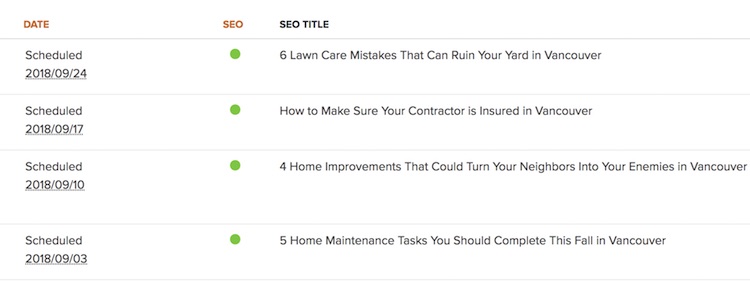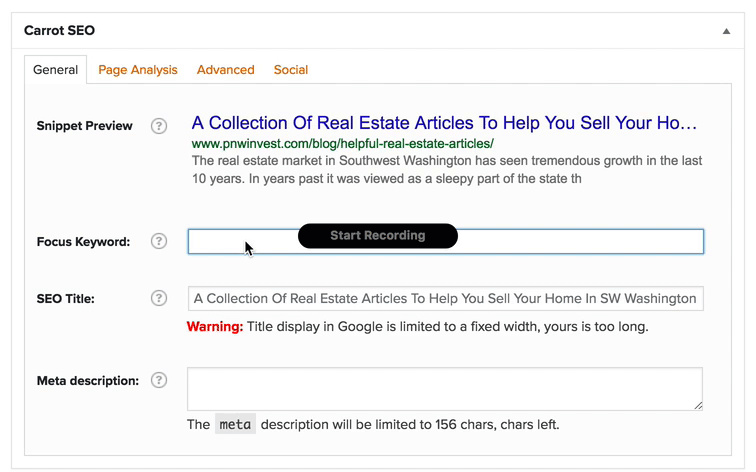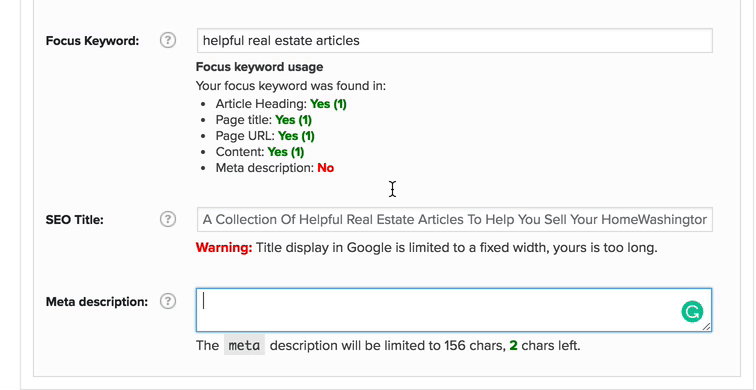There is no better color than green when trying to rank content on your Carrot website. If you are a Carrot member then you are familiar with the Carrot SEO tool as shown above. InvestorCarrot members know that in order for their content to have a chance at ranking in Google search they need to have the content on the page pass Carrot’s SEO checks. When your content passes you will see a green bubble next to your content.

That’s So Meta
In order to understand the Carrot SEO tool we need to quickly understand what meta data is. When I was in college a professor explained it rather simply to me and it always stuck.
Meta data is just data about data.
It truly was a light bulb moment for me.
In terms of SEO, we don’t want Google or other search engines to guess what our content is about. We should give Google as much information as we can to help them out with ranking our content how we want it to rank.
This is where meta data comes in. Google looks for a handful of specific things on each page to see what it is about. Carrot’s SEO tool allows us to hand pick what Google sees.
How To Use Carrot’s SEO Tool
I will break down how to use the tool in 5 easy steps.
The most important thing to have before you start trying to optimize your content is an idea of which keyword you want to rank for. Once you know the keyword you can start to optimize the page for that keyword.
Here are some general rules for trying to rank content on your Carrot website.
- Each page should rank for its own keyword
- For example: If your homepage is ranking for “we buy houses Albany” don’t try and rank a landing page or blog post for that term.
- Localize each page to your target market so local leads can find you
- Don’t forget about closely related terms and long tail keywords
- For example: In the example above, if your home page ranks for “we buy houses Albany” try and rank a similar page for “we buy any house in any condition Albany”.
- Add LSI keywords to your content in a natural way
- LSI (Latent Semantic Indexing) will be covered later in this post. But these are keywords that are similar to your main keyword.
- For example: “Sell my house fast” and “Sell your house fast” might be viewed in Google’s eyes as closely related.
Step 1 – Put Your Focus Keyword Into Carrot’s SEO Tool
The tool can be very particular so make sure you pay attention to capitalization and don’t add any commas in there (unless you want to rank for the keyword with commas).
For this example, I will target “helpful real estate articles”

Step 2 – Create Your SEO Title
The SEO Title Tag is one of the first things Google’s crawler will see when trying to understand what your page is all about and how it should be ranked.
The title tag should be…
- 50-60 characters (including spaces) according to searchenginewatch.com
- Compelling
- Include the keyword
- Have an H1 tag on the page that matches it
- Be human readable and not spammy
Let’s take a look at a couple SEO titles for our example.
Good Example: “A Collection Of Helpful Real Estate Articles To Help You Sell“
Bad Example: “Helpful Real Estate Articles – Read Our Articles On Real Estate“
It might take some playing around to get your title to be short and concise. Carrot’s SEO tool will tell you if it’s too long.
What happens if your SEO Title Tag is too long?
It won’t be a huge deal but Google’s algorithm will ignore the extra content and it will look a little funny in the search results. It is best to try and keep your title within the allocated amount of words and spaces.
If you need help writing your title tag look at the h1 tag (the first heading) on your Carrot website and try it out.
By default Carrot’s SEO tool will grab that and put it as the Title Tag for that page.

Step 3 – Craft A Compelling Meta Description For Readers
The meta description is an important part of SEO. It does more for your ranking than meets the eye. From a purely technical standpoint, it gives more context to the search engines about what is on the page.
But it also shows below the link in most search engines and it’s your chance to try and hook the visitor into clicking on your link.
Struggling to get clicks in search? Check out this post.
One of the most important things to understand about SEO is that you are competing for attention as much as you are rankings. If your website ranks #1 but everyone who clicks on it immediately leaves because it didn’t answer their question, you won’t remain #1 for long. So writing a compelling meta description is the first step on getting the click.

Step 4 – Make Sure The Heading Has Your Target Keyword
This is where a lot of investors get confused when trying to turn their Carrot content from orange to gree in the tool.
They think the SEO Title is the same as the Article Heading. It’s a finer point. But the SEO Title Tag is behind the scenes (in the code of your website) and the Article Heading is the first heading on your Carrot website.
They should be close if not the same.
After all, they are both using the same targeted keyword.
For ALL pages on your Carrot website, you can make the H1 tag in the Hero section. If you are writing a blog post the title of the blog post is automatically turned into an H1 and put on the page.
It’s a good habit to just name the title of your page the same as the keyword you are targeting (it helps you remember which keyword that page is optimized for).
Here is an example of my homepage with its keyword

There is also another big benefit of making the name of your page the same as your keyword.
You will notice that one of the items in the Carrot SEO tool is page URL. By default, Carrot takes the name of the page and converts it into a URL with a hyphen between each word. This is a common thing on blogs and if you make your page the name of the keyword you will pass that part of the keyword tool.
Step 5 – Add The Keyword To Your Content
This might be the hardest part of trying to rank content on your Carrot website…writing content.
You want to do two things with your content
- Engage the visitor and answer their question
- Write in a way that let’s Google know what is on the page
So how do you do that?
Remember when I mentioned LSI keywords earlier in the post?
They sound scary and confusing but really they are just words and phrases that are closely related.
By default Carrot’s boilerplate content contains a lot of LSI keywords.
But if you are creating a new page or trying to optimize a current page you will need to make sure the exact keyword and a few broad keywords are in your content.
Again if you need help with keywords check out an earlier post I wrote about it here.
Wrapping It Up
Ranking content on your real estate investor website isn’t as hard as some make it out to be. It takes persistence and following some general guidelines to get the most out of your time.
Once you learn what it takes to get a page to green on your Carrot site it just becomes rinse and repeat.
I would strongly suggest you write down your process and make a checklist to help you remember what you are doing.
The best part about documenting your SEO plan and strategy is you can hand it off to a teammate, VA, family member, intern or someone else to help you rank more and more of your content.
One of my favorite things to do on the weekend is to sit down and think of some content ideas for my real estate sites and personal blogs and start writing.
I try and write uninterrupted and don’t think about optimizing the page (I already have a keyword in mind before I write). Once that is done I just follow my process and get the page to green before I call it good.
You might be saying, “but all my pages are green and I am still not ranking“.
This very well could be true.
But what this tells me is you have done an excellent job of focusing on your on page SEO and need some help with your off page SEO.
Off page SEO is the other side of the coin when it comes to real estate investor SEO and involves backlinks, citations, and how other websites view your content.
But that is for another blog post.
Hit me up in the comments if you are struggling to turn your Carrot content from red/orange to green.
I have literally turned hundreds of pages green during my time at Carrot and I am confident I can do the same for your website.